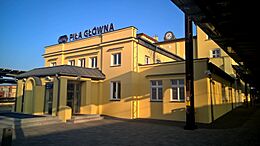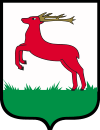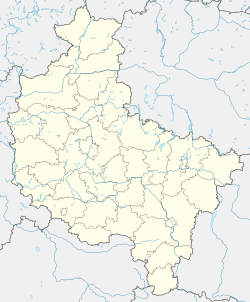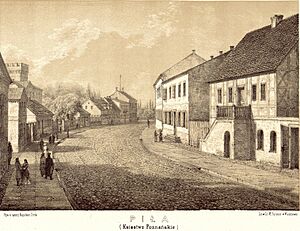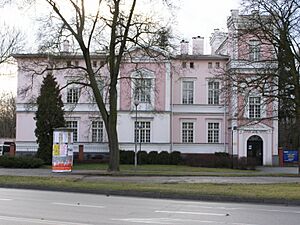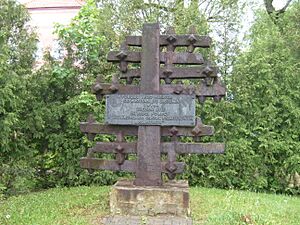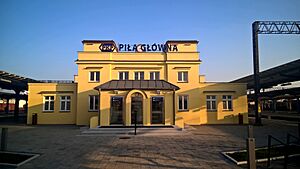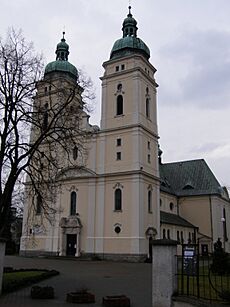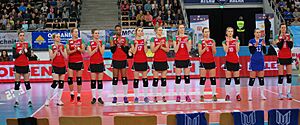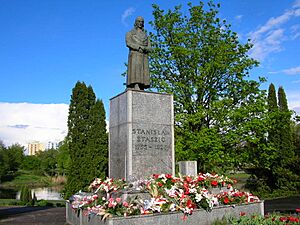Piła facts for kids
Quick facts for kids
Piła
|
|||
|---|---|---|---|
|
|||
|
|||
| Country | |||
| Voivodeship | |||
| County | Piła County | ||
| Gmina | Piła (urban gmina) | ||
| Established | 14th century | ||
| Town rights | before 1449 | ||
| Area | |||
| • Total | 103 km2 (40 sq mi) | ||
| Highest elevation | 134 m (440 ft) | ||
| Lowest elevation | 50 m (160 ft) | ||
| Population
(31 December 2021)
|
|||
| • Total | 71,846 |
||
| Time zone | UTC+1 (CET) | ||
| • Summer (DST) | UTC+2 (CEST) | ||
| Postal code |
64-900, 64-920, 64-931, 64-933 to 64-935, 64-970
|
||
| Area code(s) | +48 067 | ||
| Car plates | PP | ||
| Climate | Dfb | ||
| Website | http://www.pila.pl | ||
Piła (pronounced PEE-wah) is a city in northwestern Poland. It's the capital of Piła County and is located in the Greater Poland Voivodeship (a type of province). In 2021, about 71,846 people lived there. This makes it the third-largest city in its province, after Poznań and Kalisz.
Piła is built on the Gwda river and is known for its many green spaces, parks, and thick forests nearby. It's also an important place for roads and railways, connecting major cities like Poznań and Szczecin.
Contents
- What Does the City Name Mean?
- A Look Back at Piła's History
- City Climate
- Economy
- Places to Visit
- Sports Teams
- Famous People From Piła
- Piła's International Friends
- Images for kids
- See also
What Does the City Name Mean?
The name Piła is a Polish word that means "saw". This name was often given to villages where people worked as woodcutters for a local noble. The German name for the city, Schneidemühl, also means "sawmill".
A Look Back at Piła's History
Early Days in the Kingdom of Poland
Piła started as an old fishing village. In the 13th century, after the first Mongol invasion of Poland, many German settlers came to this forest-filled part of Poland. This changed after Poland, led by King Casimir IV Jagiellon, defeated the Teutonic Knights in 1466.
How Piła Grew
A Slavic village of woodcutters might have been in Piła even before other towns nearby. In the 14th century, Piła grew because it was on the Gwda river, close to where it joins the Notec river.
In the 1380s, a document linked to Queen Jadwiga of Poland suggests that Piła became a town around that time. The town might have had two names, Piła and Snydemole, because it had a water-powered sawmill from the beginning.
Records from 1449 mention a sawmill and a local governor. In 1456, a letter from Frederick II, Elector of Brandenburg complained that people from Snydemole and Piła were raiding his lands. This might mean Piła was already an important place.
Becoming a Royal City
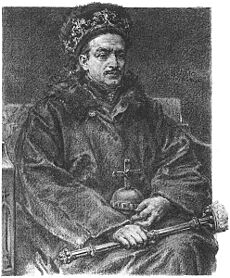
Until 1480, Piła was owned by a noble family. Then, it was given to King Casimir IV Jagiellon, and Piła became a royal town. It was part of the Poznań region in the Greater Poland Province.
On March 4, 1513, King Sigismund I the Old gave Piła its own city rights. This was a big deal because it gave the people of Piła the right to govern themselves and have their own courts. They could also own property, trade, and hold important market fairs.
Life in the 16th Century
In 1518, Piła was bought by Hieronymus von Bnin, and later it became property of the powerful Gorka family. This family was known for being kind to the town's people.
In 1548, Piła got a special rule that stopped potters from outside the town from selling their goods in Piła's markets. In 1561, they got a fishing rule. Piła was a small town with about 750 people in 1563. Most houses were simple, made of wood and clay, with straw roofs.

In 1576, King Stephen Báthory of Poland confirmed some of the town's rights and changed the weekly market day from Thursday to Monday. Over the next 150 years, many of Piła's rights were re-issued, often because fires had destroyed the old documents. In 1593, King Sigismund III Vasa also confirmed Piła's old rights.
Queen Constance and the Town's New Look
When King Sigismund III Vasa married Princess Constance of Austria in 1605, he gave Piła to her as a wedding gift. Queen Constance made many changes to Piła. She made sure that many Protestant churches in the area were given to the Catholic Church.
After a big fire in 1619, Queen Constance helped rebuild the Catholic Church. But in 1626, another huge fire destroyed the whole town, including the new church. Constance then ordered a survey of the town and decided on a new layout. She also decided that Jewish and Christian people should live in separate areas. The Jewish community had to move to a special neighborhood, often called Judenstadt (Jews' town). This area was separated from the rest of the town by a trench or a fence.
A new church was built in 1628. New houses were made of brick and stone, and the town was rebuilt in a simple Renaissance style. Polish Kings confirmed Piła's rights again in 1633, 1650, 1660, 1670, 1688, and 1716.
In 1655, during a time called the Deluge, Swedish soldiers took over the town and destroyed most of its buildings. Later, Polish soldiers attacked the town, blaming the people of Piła for helping the Swedes. During other wars, like the Great Northern War, the town suffered even more. The plague also spread through the town.
Under Prussian Rule and the Duchy of Warsaw
In 1772, Poland was divided by its neighbors, and Piła became part of the Kingdom of Prussia. Its name was officially changed to Schneidemühl. The Prussian King Frederick II of Prussia encouraged new German Protestant settlers to move there.
In 1781, another big fire destroyed half the town. In 1793, a Polish army briefly took Piła back. But after Prussia's victory in 1807, Piła became part of the Polish Duchy of Warsaw, which was semi-independent.
The 19th Century: Industry and Railways
After the Congress of Vienna in 1815, Prussia took control of Piła again. The city became part of the Grand Duchy of Posen. The Polish language was limited in offices and schools, and many German settlers moved to the city.
In 1834, a fire destroyed a large part of the city center and the city's old records. But the city was rebuilt soon after.
In 1851, the city got a railway connection to Berlin and Bydgoszcz. A special roundhouse for trains, called the historical roundhouse, still stands from this time.
By the end of the 1800s, Piła became a very important railway center and one of the biggest towns in the Province of Posen. It also became a military town for Prussia. In 1892, a drilling accident caused widespread flooding, damaging many houses.
World War I and Airplanes
In 1914, Piła became an independent city. Before World War I, a company called Albatros Flugzeugwerke built a factory in Piła to make military airplanes for the German Army.
During World War I, the Germans had a prisoner-of-war camp in the city. It held prisoners from many Allied countries, including Russia, Britain, and Australia.
Between the World Wars
After World War I, in 1918, Poland became independent again. The Greater Poland Uprising started, aiming to bring the region back to Poland. Polish people in Piła were treated badly by the Germans for supporting Poland.
After the Treaty of Versailles, Piła was not given to Poland. The new border between Poland and Germany was only about 5 kilometers (3 miles) south of the city.
In 1922, Piła became the main administrative center for a new area called the Frontier March of Posen-West Prussia Province. In 1925, many people from areas given to Poland moved to Piła, making its population grow to about 37,518.
Nazi Rule and World War II
When the Nazis came to power, life became very difficult for the Jewish community in Piła. Unfair treatment of Jewish people became official.
During a terrible event on November 9-10, 1938, the city's 100-year-old synagogue was set on fire by the Nazis. In 1939, many Polish activists were arrested in the city and sent to special camps. A camp for Sinti and Romani people was also created.
On March 21, 1940, the last remaining Jewish people in Piła and the surrounding area were arrested and forced to live in very difficult conditions in camps. Over the next two years, they were sent to various forced labor camps. During World War II, a camp for civilian prisoners of war called "Albatros" was set up. Poles were forced to work in local aviation factories. Several British prisoners of war escaped, and the Polish resistance helped them get to Sweden by sea.
The city became part of the Pomeranian Wall, a line of defenses. In 1945, Adolf Hitler declared Piła a fortress. During the East Pomeranian offensive, Polish and Soviet forces captured the city on February 14, 1945, after two weeks of heavy fighting. About 75% of the city was destroyed, and almost 90% of the historic city center was in ruins.
Piła in Post-War Poland
After the war, in 1945, Piła became part of Poland again, with a new government supported by the Soviet Union. The city's old Polish name, Piła, was brought back. Many German residents moved away or were asked to leave, and Polish people from other parts of Poland, especially those who had been forced to leave their homes in the east, moved into the city. The historic city center was only partly rebuilt.
In August 1980, workers in Piła joined nationwide strikes against the communist government. These strikes led to the creation of the Solidarity organization, which helped end communist rule in Poland.
From 1975 to 1999, Piła was the capital of the Piła Voivodeship (province). This led to a period of fast growth for industry in the area. Today, Piła is known for its green spaces and parks, and for its speedway club, Polonia Piła.
City Climate
Piła has a climate with mild differences between hot and cold, and it gets enough rain all year.
Economy
Main Companies
- Signify (formerly Philips Lighting Poland), Piła
- Quad/Graphics Europe, Piła
Places to Visit
- Stanisław Staszic Museum: This is in his old house. Stanisław Staszic was an important Polish thinker.
- Old arsenal building from the 1800s.
- St. Stanislaus Kostka's Church: Built in a Neo-Gothic style.
- Holy Family Church: Built in a Neo-baroque style.
- St. Anthony's Church: Built in 1930, it has the biggest wooden statue of Jesus in Europe, which is 7 meters (23 feet) tall.
- War Cemeteries: Two cemeteries in Leszków for soldiers from World War I and World War II.
- "Atrium Kasztanowa" and "Vivo!" - Modern shopping centers.
- "Aqua Park" - A fun water park.
- "Park na Wyspie" - A large park on an island with an outdoor gym, playground, and fountains.
Sports Teams
- Polonia Piła – A speedway team that won the Polish Championship in 1999.
- PTPS Piła – A women's volleyball team that has won the Polish top league four times.
- Joker Piła – A men's volleyball team.
- Basket Piła – A men's basketball team.
- Gwda Piła – An athletics club.
- Gwardia Piła – An athletics club.
Famous People From Piła
- Dirk Galuba (born 1940), German actor
- Carl Friedrich Goerdeler (1884–1945), German politician
- Andrzej Gronowicz (born 1951), Polish athlete
- Jo Mihaly (born Elfriede Alice Kuhr) (1902–1989), German dancer and writer
- Daria Pająk (born 1993), Polish bowling player
- Kasia Smutniak (born 1979), Polish actress
- Stanisław Staszic (1755–1826), a very important Polish thinker.
Piła's International Friends
Piła has "twin town" or "sister city" relationships with other cities around the world. This means they share culture and ideas.
Twin Towns
 Châtellerault, France
Châtellerault, France Schwerin, Germany
Schwerin, Germany Imola, Italy
Imola, Italy
Former Twin Town
 Kronstadt, Russia
Kronstadt, Russia
On March 1, 2022, Piła stopped its partnership with Kronstadt because of the Russian invasion of Ukraine.
Images for kids
See also
 In Spanish: Piła para niños
In Spanish: Piła para niños






